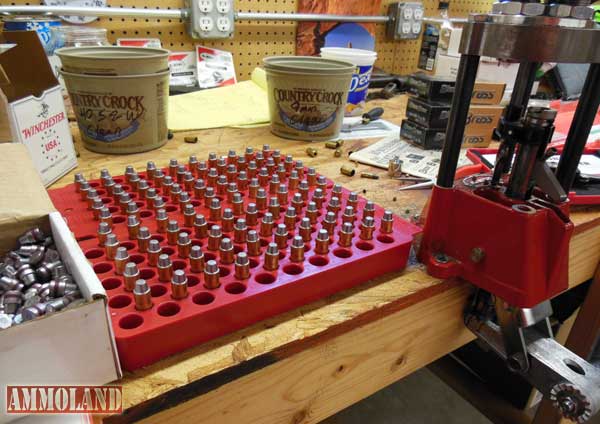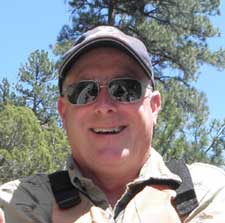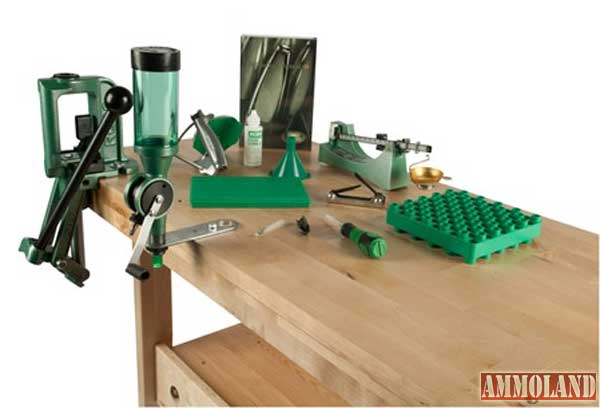

Lansing, Michigan – -(Ammoland.com)- The ongoing ammunition shortage has many shooters rethinking their supply strategies.
Much like finding a generator in the aftermath of a hurricane, finding ammo or handloading components in today’s marketplace continues to be sporadic and expensive at best.
People are settling on whatever they can get their hands on. Forward-thinking handloaders on the other hand are weathering the storm much better, because of the inherent nature of loading their own.
A recent poll from www.ShooterSurvey.com indicates that the art of handloading may be on the rise. Although cartridge component availability remains scarce today, many do-it-yourselfers have been able to dodge supply issues with components from their shelves.
For example, powder is purchased in one-pound (or greater) containers – enough to load some 700 rounds of .40 caliber handgun cartridges. Loading less than that means leftover powder. Primers purchased in 1000 count lots, work the same way. Handloaders always save spent brass and typically have some on hand, as well. Bullets are purchased in lots of 50, 100, or more and wise handloaders keep their favorites in stock to varying degrees
Justification to handload ammo may be based on factors such as cost savings, better accuracy, or the ability to produce cartridges not found elsewhere – all good reasons to be sure. But, let’s take a closer look into the savings rationale.
Saving money is at the top of the priority list for many handloaders. But in reality, several factors could actually turn the effort more costly. Considering the cost of start-up equipment, which runs into the hundreds of dollars, it takes a lot of in-house manufacturing to break even. Obviously, more loading equals quicker payback, which brings another factor into the cost equation.
If one compares his per-box homebrewed ammo component cost to that of factory ammo, he looks like a genius. But, in the real world, the DIY guy ends up shooting much more, because of availability and cost, so he really doesn’t save money. He may be having lots of fun and improving his skill set, but the overall budgetary impact may be a wash. Not that there’s anything wrong with shooting more and enjoying it more, but it is what it is. Just think of loading your own as a sound investment that pays dividends indefinitely.
When it comes to accuracy, however, handloaders can gain an edge over store-bought rifle fodder by producing cartridges tailored to specific firearms. To do so requires some specialty tools, but the payoff can mean unparalleled precision.
Experimenting with different powder charges, bullets, and primers, and subsequently range testing, can be rewarding. But in four decades of experimentation, I’ve found nothing more consequential in handloading for accuracy than proper bullet seating. Consider that factory ammo must fit all firearms; custom loads can be made to fit your specific firearm by seating bullets to within mere thousands of an inch from bore engagement. Thus, dreaded bullet jump can be minimized, or even eliminated, and only custom ammo can afford this accuracy advantage.

Start-up loading kits will include everything for a beginner, but a few relatively inexpensive tools are needed for precise bullet seating: an overall case length gauge, modified cases and a bullet comparator set. These specialty tools will allow the loading enthusiast to measure the chamber of a given firearm in conjunction with the actual bullet selected. From this maximum length, handloaders may back off the cartridge length 10,000ths of an inch (more or less) and begin range testing until satisfied with results.
So, if you’ve considered “rolling your own”, understand there’s more to it than meets the eye.
Achieving a greater level of satisfaction with your own “inventions”, however, can make the plunge downright satisfying.
About Glen Wunderlich
Charter Member Professional Outdoor Media Association (POMA). Outdoor writer and columnist for The Argus-Press (www.argus-press.com) and blog site at www.thinkingafield.org Member National Rifle Association (NRA), Michigan United Conservation Clubs (MUCC), member U.S. Sportsmen’s Alliance (USSA), Quality Deer Management Association (QDMA), Commemorative Bucks of Michigan (CBM). Adjutant of Perry, Michigan Sons of Amvets Post 4064 and Chairman Perry (MI) Youth Hunt Extravaganza, a sanctioned event of Perry Sons of Amvets held the fourth weekend of September each year.

I do not think .22’s can be reloaded as they don’t have regular primers but something like a burman, and I know I am spelling it wrong, primer. The firing pin hits on the side of the bullet, unlike regular primers which the pin hits in the middle. Thanks, BB. I already pretty much knew that much. You can dig out the lead fired at a range and melt it to form new bullets but you have to wear rubber gloves and not breath the fumes from lead. With shotguns, I collect everyone’s old hulls and also use wads again,… Read more »
an old reloader once told me,you don’t save money reloading….but you do shoot a hell of a lot more.
But, I haven’t found out how to reload .22’s yet.
Though everything may be in short supply, everything is barterable. I have reloaded Shotgun, rifle and hand gun loads. I have even poured my own bullets. With today’s shortages you must learn to do what you can and become immersed in the whole range of ownership and functionality. Yes a loading press can be expensive at the same time it is a valuable learning experience that opens a whole new range of possibilities. Load experimentation (within limits) allows for a great deal of savings and fun. In the long run the savings may allow for the additional cost of competition… Read more »
Dear Becker, simply buy a reloading manual from any of the reloading manufacturers and the mysteries of metallic cartridge reloading will be revealed to you. It appears that most if not all of them start with the basics and progress from there. In addition many local firearms shops provide basic instruction for a minimal fee and sometimes even for free. Hope this gives you some places to start. Good Luck. bb
I have been reloading my handgun ammo for several years, 9mm, 40 S&W and 45 ACP. I find it enjoyable and cost effective. I have cut way back on the number of rounds I shoot during a training session so as to save my ammo and components. When I go to the range I can pickup all the brass I want as no one there re-loads. I agree that powder, primers and bullets (once easy to find) are now difficult due to hoarding.
We’ll take a breath in 2016 when with the grace of God we do not have a Democratic POTUS.
Unfortunately, primers, powder, brass and bullets are in just about as tight a supply situation as factory ammo. A significant part of the problem comes from the same group as those causing ammo shortages: hoarders and opportunists. Hoarders are buying everything they can and socking it away and opportunists are buying the rest to turn around and resell at outrageous prices.
Everybody needs to take a deep breath.
I have reloaded shot gun shells since 1983, and that is the last time I bought a store bought box. Shot gun reloading is easy and I have looked into rifle and pistol reloading. I have never been able to really understand what I really need. It seems that I need something different for each caliber and looks to be very costly, to me. If someone can let me know exactly what I need and what I need to change to each caliber, I would appreciate it. I need the whole process explained to me, from A to Z.